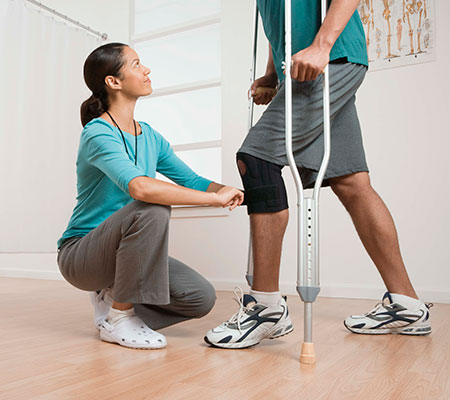
Work with your physician and physical therapist to determine your brace needs.
A recent knee injury, surgery or pain prompts your physician or physical therapist to recommend using a knee brace. With a wide range of braces to choose from, which one is most effective?
“Brace selection is based on the structures involved and the amount of stability required,” said Christopher Bizjak, Marshfield Clinic Health System physical therapist. “Look for what offers the most protection while still offering appropriate mobility.”
Knee brace features to consider:
- Hinged: Provides stability for ligament sprains.
- Compression or sleeve style: Provides stability and pain control for minor strains or sprains.
- Wraparound: Provides stability and pain control for minor strains or sprains. Wraparounds are easier to apply to a larger area or use when you can’t pull on a compression sleeve.
- Band/strap: Provides pain control for tendonitis issues.
- Custom knee brace: Provides stability for ligament major strains or tears.
While compression braces are the most common, they offer the least amount of stability. When choosing your brace, Bizjak recommends you look for proper size and fit so it’s positioned correctly and snug, but not too tight.
Life and wear of your brace
How long you should wear your brace is based on the type and severity of your injury. You should work closely with your physician and physical therapist to determine your needs.
Some more severe injuries may leave permanent instability or hypermobility that require lifelong bracing,” Bizjak said.
An example is unloader braces, which shift the weight off the most damaged part of the joint to reduce the pain associated with osteoarthritis.
Watch for skin irritation. As long as it fits appropriately, the brace should be worn for activities as directed by your health care professional. Braces can be worn for preventive purposes but they cannot guarantee 100 percent protection.
Pay attention to the fit of brace, because they can wear out. “Brace life depends on the amount of wear and tear. Compression braces lose the elastic component and have an expiration date associated with the brace life,” Bizjak said.
If you have any questions or concerns about your recovery or use of your brace, Bizjak encourages you to contact your physician.
Related Shine365 stories
What’s the science behind taping and bracing?
Kick these common knee pain causes


I sustained a spinal chord injury and Brown Sequard Syndrome from an RTA 14 years ago.I am mobile but limited due to unreliable support of both knees – but never at the same time.I am 75 years old and have the inner capacity to be very active and could be if my knees got the appropriate help!
Knee brace type is based on the area such as above patella, inner pain etc, or injuy type. Unfortunately I, this article does not have such info.
When choosing a knee brace, look for levels of protection ranging from 1 to 3+ . A level 1 brace offers the least amount of support, but is the most flexible, such as a knee sleeve. It’s best for pain relief and mild to moderate support when remaining fully active.
This article was very helpful. The last knee brace I rec'd doesn't fit well and I don't want my insurance to have to pay for another visit to get another brace. What options do I have? I am on S.Security and cannot afford to buy one myself. I have never even heard of an unloader brace and will look further into it. Thank you
Hi, Ginna. I just heard back from Christopher Bizjak, physical therapist, and he suggested contacting the facility that issued your brace initially to see if there can be adjustments to your current brace. He also mentioned that it may be helpful for you to contact your primary care provider to discuss if an unloader brace is an appropriate treatment option for your current diagnosis. -Kirstie
Thank you Kirsten, I will talk to my primary care doctor but he cannot give me another brace. I'm told I have to get one from a Sports Med. MD. The one I have isn't adjustable.
I have arthritis in both knees. I'm taking Glucosamine which helps, but I still have stiffness after sitting for a while. My legs get tired after a while when walking. Sometimes but not often my feet will hurt. I'm doing okay , but if there was something else I could try that would help. While in the woods I ware sleeves on my knees and once in a while doing other activities. I'm 72 years old and I'm very active.
Hi, Ralph. Have you tried our knee exercises for arthritis? https://shine365.marshfieldclinic.org/bone-joint/leg-exercises-to-relieve-arthritis-pain/
-Kirstie